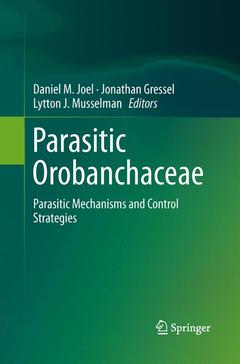Description
Parasitic Orobanchaceae, 2013
Parasitic Mechanisms and Control Strategies
Coordinators: Joel Daniel M., Gressel Jonathan, Musselman Lytton J.
Language: English
Subjects for Parasitic Orobanchaceae:
Keywords
Agronomic management; Biocontrol; Chemical control; Root parasites; Weed
Publication date: 08-2015
Support: Print on demand
Publication date: 07-2013
513 p. · 15.5x23.5 cm · Hardback
Description
/li>Contents
/li>Comment
/li>
This book was written in response to significant recent advances in understanding the mechanisms of parasitism in the Orobanchaceae, and breakthroughs in the control of the parasitic weeds Striga and Orobanche. It consists of 26 contributions by internationally recognized leading scientists. The main book chapters are grouped into two parts:
· Part I ? The Orobanchaceae and Their Parasitic Mechanisms
· Part II ? The Weedy Orobanchaceae and Their Control
The first part provides cutting-edge information on all key aspects of plant parasitism, such as the structure, development and function of the haustorium; nutrient transfer and the physiology of the parasite-host association; host reaction to parasitic plants; seed production and germination; the strigolactones and host-parasite signaling mechanisms; the parasite genome, phylogenetics, evolution and epigenetics; and ecology. Topics of the second part include: the problem posed by the weedyparasites; population diversity and dynamics; molecular diagnosis of seed banks; and detailed discussion of the various management strategies, including agronomic, chemical and biotechnological approaches, as well as host breeding for resistance, allelopathy and biological control.
This book is intended for plant scientists, university lecturers and students, agronomists and weed specialists, breeders and farmers, extension personnel and experts in tropical and subtropical agriculture.
Introduction: The parasitic syndrome in higher plants.- The haustorium and the life cycles of parasitic Orobanchaceae.- Functional structure of the mature haustorium.- Haustorium initiation and early development.- Haustorium invasion into host tissues.- The physiology of the established parasite-host association.- Host reaction to attack by root parasitic plants.- Seed production and dispersal in the Orobanchaceae.- The seed and the seedling.- Induction of germination.- Germination eco-physiology.- Are karrikin signalling mechanisms relevant to strigolactone perception?- Changing host specificities: by mutational changes or epigenetic reprogramming?- Phylogenetic relationships and evolutionary trends in Orobanchaceae.- Genomic evolution in Orobanchaceae.- Ecology of hemi-parasitic Orobanchaceae with special reference to their interaction with plant communities.- Weedy Orobanchaceae – The problem.- The parasitic weeds of the Orobanchaceae.- Population diversity and dynamics of parasitic weeds.- Molecular diagnosis of parasite seed banks.- Marker-assisted and physiology-based breeding for resistance to Orobanchaceae .- Integrated agronomic management of parasitic weed seed banks .- Chemical control.- Biotechnologies for directly generating crops resistant to parasites.- Allelopathy.- Biocontrol.




